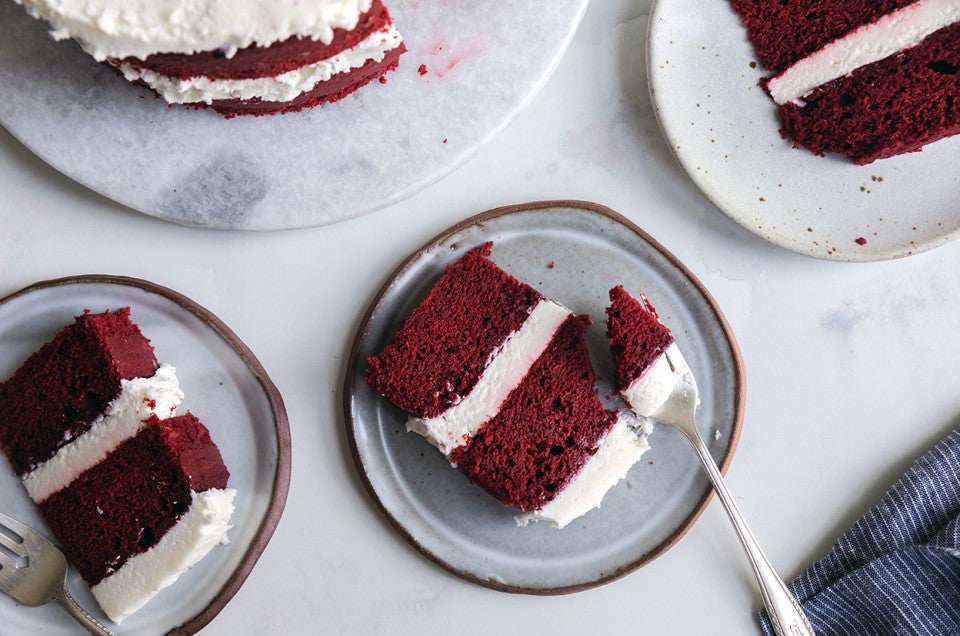


Editor's note: This post was updated in August 2022 to more accurately reflect our gluten-free conversion guidelines and product offerings.
When it comes to converting baking recipes to be gluten-free, things can quickly get complicated.
You might be wondering: Can't I just make these old favorites with gluten-free flour and cross my fingers for the best?
Well, you could, but it's not always so easy. We begin the conversion process with an acceptance of the things that will work and those that will not. Your time and ingredients are hard-earned, so I hope reading this brings new confidence to your gluten-free baking and invites you to take some chances on experimentation. But first, two easily remembered suggestions:
1) For making cakes, muffins, cookies, and yeast doughs, a stand mixer is your new baking BFF! The power of the machine will stir your blends, aerate your batters, agitate your doughs, and hydrate your gums better than mere muscle alone. If you don't have one already, it's the best investment you'll make.
2) When adding xanthan gum to a recipe that doesn't already call for it (and baking with a gluten-free flour that doesn't include it), use about 1/4 teaspoon per cup of flour. Blend it evenly into your dry ingredients before mixing.
Baker's tip: Have you ever spilled xanthan gum on your work space and tried to clean it up with a wet sponge? Unless you want a counter-top slip-and-slide (not to mention a few bucks down the drain), it's best to use a bench knife for cleanup, so you can maneuver the gum back into its container.
It's easy to make traditional recipes gluten-free with King Arthur Gluten-Free Measure for Measure Flour. It's a simple 1:1 substitute for all-purpose or whole-grain flour that's designed to be easily swapped into most of your favorite non-yeasted recipes. It's ideal for almost all classic baking recipes — brownies, cookies, cake, biscuits, pancakes, muffins, etc. — and doesn't require any additional changes to the recipe.
But if you're baking with gluten-free all-purpose flour — either our King Arthur Gluten-Free All-Purpose Flour or another type — and want to convert classic recipes to be gluten-free, you still can. It just takes a little extra adjustment. Here's what to do:
Because they lack the elastic strengthening network of gluten, cookies that are gluten-free are more prone to baking up crumbly, dry, and gritty without the proper recipe adjustments.
In the absence of gluten, and with a low hydration rate, gluten-free cookies rely on fat as a key ingredient to help create great texture. Fat can help smooth out the mouthfeel by reducing the perception of un-hydrated starch (what can cause that sandy feeling in your mouth).
Fat has a low hydration rate; even though it feels wet and slippery, it has very little, or no water in it. So increasing its level in a cookie recipe will not encourage a cake-like texture. Butter and shortening can be increased by up to 2 tablespoons, and high-fat nut flours such as almond or hazelnut can be used to replace a portion of the flour in the recipe.
Xanthan gum is intended to lock in moisture, enhance texture, and control spread in most gluten-free recipes, but it has a very low level of water to work with in cookie dough. Resting the dough for at least an hour (overnight is best) before baking is the best way to ensure that the gums and starches are hydrated to their full potential. Because of the lower level of liquid in cookie dough, the hydration rate is slower; thus a longer rest is necessary.
Can you leave out the xanthan gum? Sure you can, though the cookies will spread out and be thin, fragile, and crisp. I would only recommend doing this with a drop cookie recipe. Definitely use the gum for shortbread, butter, and rollout-style cookies.
Adding liquids (egg, water, milk) will increase hydration and develop structure, but keep in mind that they may also promote a cake-like texture. Using fruit purées in place of some of the liquid content can aid in building structure.
Gluten-free yeast doughs are not easily convertible due to the many alterations needed for leavening and structure. Eggs, air, yeast, xanthan gum, and sometimes even chemical leavening agents are necessary to produce an ideal result along with sufficient hydration (a higher ratio than with wheat-based breads).
The short answer? Save yourself an expensive trial-and-error game and locate a gluten-free recipe for yeast bread that has been specifically developed for the best hydration and balance of ingredients like eggs and fat. And learn more about baking great gluten-free bread in our previous post, Gluten-free yeast baking.
Cakes are one of the easier, more straightforward treats to recreate without gluten. Loaf-style quick breads and muffins require the same ingredient guidelines as cakes.
Cakes, too, need a calibration of xanthan gum (1/4 teaspoon per cup of flour is sufficient) and additional liquids. I usually suggest adding an extra egg to efficiently provide leavening, structure, and liquid.
Though it's important to aerate a cake batter, take care not to over-beat, as it can cause deflation in the oven. Baking cake to an internal temperature of 210°F ensures minimal sinking as the cake cools.
Giving cake and quick-bread batters a 10 to 15-minute rest before baking will allow the starches and xanthan gum to fully hydrate. Also, if you're adding fruit, chocolate chips, or nuts to your batters, complete the rest before stirring them in, to prevent them from sinking to the bottom during the bake. When the flour and xanthan gum are hydrated, the batter will thicken and be able to suspend any added elements successfully.
Want to learn more? Read through our Gluten-Free Baking Guide, and leave any questions in the comments, below! And remember, the easiest way to make traditional recipes gluten-free is with King Arthur Gluten-Free Measure for Measure Flour, a simple 1:1 substitute for all-purpose or whole-grain flour in non-yeasted recipes.